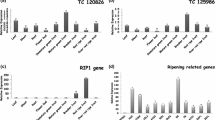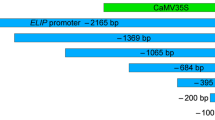Abstract
Polygalacturonase (PG) is the major cell wall degrading enzyme of tomato fruit. It is developmentally regulated and is synthesised de novo in ripening fruit. Genomic clones encoding a PG gene of tomato (Lycopersicon esculentum Mill cv. Ailsa Craig) have been isolated, mapped and sequenced. The sequence of the protein-coding region is identical to that of a PG cDNA [20]. Comparison of the cloned restriction fragments with genomic Southern data suggests that there may only be one gene for PG per haploid genome. The PG gene, which covers approximately 7 kb, is interrupted by 8 intervening sequences ranging in size from 99 bp to 953 bp. The transcription start point was identified by S1 mapping and primer extension analysis. About 1.4 kb of 5′ flanking DNA has been sequenced. This contains putative TATA and CAAT boxes and also direct repeat sequences. A transcriptional fusion has been constructed between the putative 1.4 kb promoter fragment and the chloramphenicol acetyl transferase (CAT) gene. Constructs containing this gene have been transferred to tomato using binary vectors. Regenerated transgenic plants express CAT in ripe tomato fruit, but not in unripe tomatoes, leaves, or roots.
Similar content being viewed by others
References
Bernatzky R, Tanksley SD: Majority of random cDNA clones correspond to single loci in the tomato genome. Mol Gen Genet 203: 8–14 (1986).
Bevan MW: Binary Agrobacterium vectors for plant transformation. Nucleic Acids Res 12: 8711–8721 (1984).
Biggin M, Farrell PJ, Barrell BG: Transcription and DNA sequence of the Bam HI L fragment of B95–8 Epstein-Barr Virus. EMBO J 3: 1083–1090 (1984).
Bradford MM: A rapid and sensitive method for the quantitation of microgram quantities of protein utilising the principle of protein-dye binding. Anal Biochem 72: 248–254 (1976).
Breathnach R, Chambon P: Organisation and expression of eukaryotic split genes coding for proteins. Ann Rev Biochem 50: 349–383 (1987).
Brown JWS: A catalogue of splice junction and putative branch point sequences from plant introns. Nucleic Acids Res 14: 9549–9559 (1986).
Carter P, Bedouelle H, Waye MMY, Winter G: Oligonucleotide site-directed mutagenesis in M13. Anglian Biotechnology Ltd., Colchester (1985).
Chomczynski P, Qasba PK: Alkaline transfer of DNA to plastic membranes. Biochem Biophys Res Comm 122: 340–344 (1984).
Colot V, Robert LS, Kavanagh TA, Bevan MW, Thompson RD: Localisation of sequences in wheat endosperm protein genes which confer tissue-specific expression in tobacco. EMBO J 6: 3559–3564 (1987).
Dean C, Tamaki S, Dunsmuir P, Faureau M, Katayama C, Dooner H, Bedbrook J: mRNA transcripts of several plant genes are polyadenylated at multiple sites in vivo. Nucleic Acids Res 14: 2229–2240 (1986).
Della Penna D, Alexander DC, Bennett AB: Molecular cloning of tomato fruit polygalacturonase: Analysis of polygalacturonase mRNA levels during ripening. Proc Natl Acad Sci USA 83: 6420–6424 (1986).
Della Penna D, Kates DS, Bennett AB: Polygalacturonase gene expression in Rutgers, rin, nor and Nrtomato fruit. Plant Physiol 85: 502–607 (1987).
Dellaporta SL, Wood J, Hicks JB: A plant DNA minipreparation: Version 11. Plant Mol Biol Rep 1: 19–21 (1983).
Farrell PJ, Deininger P, Bankier A, Barrell BG: Homologous upstream sequences near Epstein-Barr virus promoters. Proc Natl Acad Sci USA. 80: 1565–1569 (1983).
Feinberg A, Vogelstein B: A technique for radiolabeling DNA restriction endonuclease fragments to high specific activity. Anal Biochem 137: 266–267 (1984).
Fraley RT, Rogers SG, Horsch RB, Sanders PR, Flick JS, Adams SP, Bittner ML, Brand LA, Kink CL, Fry JS, Galluppi GR, Goldberg SB, Hoffmann NL, Woo SC: Expression of bacterial genes in plant cells. Proc Natl Acad Sci USA 80: 4803–4807 (1983).
Frischauf AM, Lehrach H, Poustka A, Murray N: Lambda replacement vectors carrying polylinker sequences. J Mol Biol 170: 827–842 (1983).
Grierson D: Gene expression in ripening tomato fruit. CRC Crit Rev Plant Sci 3: 113–132 (1985).
Grierson D, Slater A, Speirs J, Tucker GA: The appearance of polygalacturonase mRNA in tomatoes: one of a series of changes in gene expression during development and ripening. Planta 163: 263–271 (1985).
Grierson D, Tucker GA, Keen J, Ray J, Bird CR, Schuch W: Sequencing and identification of a cDNA clone for tomato polygalacturonase. Nucleic Acids Res 14: 8595–8603 (1986).
Heidecker G, Messing J: Structural analysis of plant genes. Ann Rev Plant Physiol 37: 439–466 (1986).
Hobson GE: The firmness of tomato fruit in relation to polygalacturonase activity. J Hort Sci 40: 66–72 (1965).
Holdsworth MJ: Characterisation of an ethylene related small multigene family from Lycopersion esculentum. Ph.D. Thesis, University of Nottingham (1987).
Holdsworth MJ, Bird CR, Ray J, Schuch W, Grierson D: Structure and expression of an ethylene related mRNA from tomato. Nucleic Acids Res 15: 731–739 (1987).
Hudson GS, Farrell PJ, Barrell BG: Two related but differentially expressed potential membrane proteins encoded by the Eco RI Dhet region of Epstein-Barr virus B95–8. J Virol 53: 528–535 (1985).
Langridge P, Feix G: A zein gene of maize is transcribed from two widely separated promoter regions. Cell 34: 1015–1022 (1983).
Maniatis T, Fritsch EF, Sambrook J: Molecular Cloning: A Laboratory Manual. Cold Spring Harbor Laboratory, Cold Spring Harbor, NY (1982).
Maunders MJ, Holdsworth MJ, Slater A, Knapp JE, Bird CR, Schuch W, Grierson D: Ethylene stimulates the accumulation of ripening-related mRNAs in tomatoes. Plant Cell Envir 10: 177–184 (1987).
Morelli G, Nagy F, Fraley RT, Rogers SG, Chua N-H: A short conserved sequence is involved in the light-inducibility of a gene encoding ribulose 1,5-bisphosphate carboxylase small subunit of pea. Nature 315: 200–204 (1985).
Mount SM: A catalogue of splice junction sequences. Nucleic Acids Res 10: 459–472 (1982).
Pressey R, Avants JK: Two forms of polygalacturonase in tomatoes. Biochim Biophys Acta 309: 363–369 (1973).
Proudfoot NJ, Brownlee GG: 3′ Non-coding region sequences in eukaryotic messenger RNA. Nature 263: 211–214 (1976).
Roberts JA, Schindler CB, Tucker GA: Ethylene-promoted tomato flower abscission and the possible involvement of an inhibitor. Planta 160: 159–163 (1984).
Sanger F, Nicklen S, Coulson AR: DNA sequencing with chain-terminating inhibitors. Proc Natl Acad Sci USA 74: 5463–5467 (1977).
Sheehy RE, Pearson J, Brady CJ, Hiatt WR: Molecular characterisation of tomato fruit polygalacturonase. Mol Gen Genet 208: 30–36 (1987).
Slater A, Maunders MJ, Edwards K, Schuch W, Grierson D: Isolation and characterisation of cDNA clones for tomato polygalacturonase and other ripening-related proteins. Plant Mol Biol 5: 137–147 (1985).
Sommer H, Saedler H: Structure of the chalcone synthase gene of Antirrhinum majus. Mol Gen Genet 202: 429–434 (1986).
Tucker GA, Grierson D: Synthesis of polygalacturonase during tomato fruit ripening. Planta 155: 64–67 (1982).
Tucker GA, Robertson NG, Grierson D: Changes in polygalacturonase isoenzymes during the ripening of normal and mutant tomato fruit. Eur J Biochem 112: 119–124 (1980).
Tucker GA, Robertson NG, Grierson D: The conversion of tomato-fruit polygalacturonase isoenzyme 2 into isoenzyme 1 in vitro. Eur J Biochem 115: 87–90 (1981).
Tucker GA, Schindler CB, Roberts JA: Flower abscission in mutant tomato plants. Planta 160: 164–167 (1984).
Werr W, Frommer W-B, Maas C, Starlinger P: Structure of the sucrose synthase gene on chromosome 9 of Zea mays L. EMBO J 4: 1373–1380 (1985).
Zainon MA, Brady CJ: Purification and characterisation of the polygalacturonase of tomato fruit. Aust J Plant Physiol 9: 155–169 (1982).
Zoller MJ, Smith M: Oligonucleotide-directed mutagenesis: a simple method using two oligonucleotide primers and a single-stranded DNA template. DNA 3: 479–488 (1984).
Author information
Authors and Affiliations
Rights and permissions
About this article
Cite this article
Bird, C.R., Smith, C.J.S., Ray, J.A. et al. The tomato polygalacturonase gene and ripening-specific expression in transgenic plants. Plant Mol Biol 11, 651–662 (1988). https://doi.org/10.1007/BF00017465
Received:
Accepted:
Issue Date:
DOI: https://doi.org/10.1007/BF00017465




